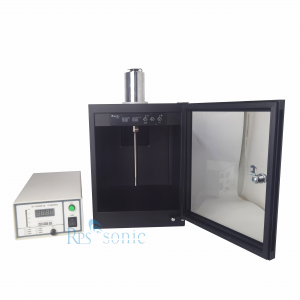Ultrasonic cell pulverizer is a multi-functional and multi-purpose instrument that uses strong ultrasound to generate cavitation effects in liquids and ultrasonically treat substances. It is widely used in the crushing of biochemistry, medical pharmaceuticals, food testing, and environmental monitoring Animal and plant tissues, viruses, bacteria, and other cell structures, as well as during chemical reactions such as emulsification, separation, and homogenization.
The structure of ultrasonic cell disruptor
Ultrasonic cell pulverizer is composed of ultrasonic generator and transducer (some are equipped with soundproof box):
1. Ultrasonic generator: The signal generator generates a signal of a specific frequency. This specific frequency is the frequency of the transducer. Generally, the ultrasonic frequencies used in ultrasonic equipment are 20KHz, 25KHz, 28KHz, 33KHz, 40KHz, and 60KHz.
2. Transducer components: Transducer components are mainly composed of transducers and horns.
3. Soundproof sound box: It can effectively reduce the noise generated during the work process and keep the laboratory quiet.
 Classification of ultrasonic cell disruptor
Classification of ultrasonic cell disruptor
1. Classified by power
The power of the ultrasonic cell pulverizer is the customer’s preferred index, which determines the quantity, size, quality and effect of the crushed objects. Therefore, all manufacturers also attach great importance to this indicator.
Under normal circumstances, scientific research units such as laboratories, laboratories, research institutes, and drug testing institutes do not use large power (generally below 500W); while biological companies, pharmaceutical factories, chemical companies and other production units use high power Most of them are around 500W-2000W. Due to the different product structures of various manufacturers, the marking methods of their power are also different. However, according to the common practice of users, ultrasonic cell pulverizers generally have the following types: 50W, 100W, 150W, 250W, 300W, 350W, 500W, 1000W, 2000W.
The output power of the ultrasonic cell pulverizer can be moderately adjusted according to needs. Standard Ultrasonic Cell Disruptor products are rated to operate at a frequency of 20 kHz. Some ultrasonic cell disruptors have an auto-tuning function that allows the frequency to vary within a small range.
2. Classified according to the diameter of the probe (tip)
To process samples of different volumes, it is necessary to choose ultrasonic cell pulverizers with different tips. Due to the different product structures of various manufacturers, the diameters of their tips are not the same. Generally, the tip ranges from micro 5mm (suitable for 1ml treatment capacity) to 25mm (suitable for 1000ml treatment capacity), with a continuous flow probe, the treatment capacity can reach 80 liters/hour. Replaceable tips are used in high energy applications where wear may occur.
Corrosion occurs where energy is delivered through the tip, leaving marks on the metal surface. Over time, where corrosion has occurred, slight pitting will develop. The tip can be polished with sandpaper or gauze, unless it is damaged to a certain extent; when this happens, the tip will have difficulty tuning the frequency and may instead make a long, sharp noise that eventually cracks.
To efficiently process a given dose of sample, there are two main factors to consider: tip size and output power. These two factors must match at the same time for the best results. If the power is small and the tip is large, the tip will not work; if the power is too high, the tip may be damaged. Please pay attention to the required model accessories when purchasing.
Post time:Apr-10-2023




